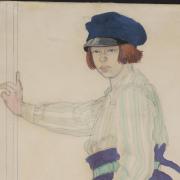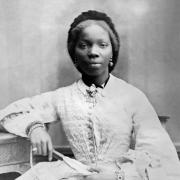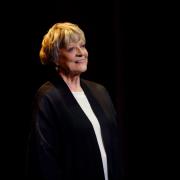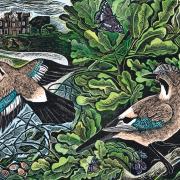Penelope Tree says being a feminist was ‘completely not a thing’ back when she worked as a supermodel in the Sixties.
With her otherworldly look, Tree was discovered at 16 at one of American author’s Truman Capote infamous black-and-white balls and was rung the next day by American Vogue’s legendary fashion editor Diana Vreeland.
The teenager swiftly became a key face of London’s Swinging Sixties, moving into photographer boyfriend David Bailey’s flat who reportedly described her as looking like an ‘Egyptian Jiminy Cricket’ even though she graced the covers of glossies worldwide including Vogue. When John Lennon was asked to encapsulate Tree in three words, he is said to have replied: ‘Hot, Hot, Hot, Smart, Smart, Smart!’
She crashed out of the fashion industry in her 20s after developing severe late-onset acne, which left her face swollen and scarred, and has largely kept out of the spotlight since then. ‘I went from being sought-after to being shunned because nobody could bear to talk about the way I looked,’ she told The Guardian.
Now 74, Tree, who lives in Sussex, is feeling reflective, thinking back to her time in the fashion industry. ‘Feminism was in such early days that it wasn’t even widely integrated,’ she says of the 1960s.‘Being a feminist was completely not a thing, whereas now, I think girls have a lot more sense of their own worth.’

Tree is revisiting her past through a slightly unusual vehicle – rather than going down the tried and tested route of a memoir, she’s written a work of fiction. Piece Of My Heart follows teenager Ari, whose alien-like looks catch the attention of the fashion industry – she becomes a model, has a turbulent relationship with an older photographer, and her career comes to an abrupt end when she develops painful adult acne.
If a lot of that sounds remarkably familiar, there are plenty of strains that echo Tree’s own life, but she’s keen to highlight that it’s not strictly autobiographical. She grew up in New York, for one – not a stately English home like Ari – and many of the characters are composites of real people rather than being based on individuals.
But still, the similarities are there, with Tree explaining: ‘It was something I really wanted to talk about and write about for a long time. I think it was quite an important thing for me to do, it crystallised a lot of feelings that I had about that whole time – feeling like it had been such a series of losses and failures.
‘I went up, and then I went plummeting down. It always stuck in my mind as something that was very formative – I lost so much confidence from that whole period, and I wanted to look at it a bit more closely.’
‘I was really young, but I also didn’t listen – I was quite stubborn and didn’t listen to people who knew better in the industry, and paid the consequences’
Reliving such a painful time ‘put me through a lot of emotion’, Tree admits, while ultimately calling the writing process ‘cathartic’.‘It was really helpful to me. I feel a lot more resolved with things that happened, even though it didn’t happen exactly the way it is [in the book]. But somehow, using your imagination to work with the past can be really transformative.’
One character who was plucked straight from reality is Ari’s boyfriend, clearly inspired by Tree’s former partner, photographer David Bailey, who credited the American-born style icon with starting the flower power movement. It’s not the most flattering of portrayals – he’s depicted as a creative genius who can be controlling and unfaithful – and Tree gave him full warning before the book was published.
‘I told him that he may or may not like it, but I did it – he said: “Oh right, that’s alright”. ‘He’s pretty cool about it,’ Tree notes – but she’s also doubtful Bailey, now 86, will actually read the novel.

Tree’s memories of this time in her life are dominated by her relationship with Bailey, which is reflected in the book.
‘When you fall in love, you think that the person you fall in love with is going to be the answer to your loneliness, to the fact that we’re all alone in the world – we come in alone, we go out alone. And that’s the way it is.
‘But when you fall in love, you have the illusion that you’re wholly bonded – at one with the other person. And as the veil slowly peels away from your eyes, you realise you’re back in the same situation, and it’s really down to you in the end, to be the person that you are.’
The relationship flamed out dramatically – ‘and then he was in a new relationship with Marie Helvin. She was on the cover of Vogue, so passing a newsagent was agony’ – with Tree saying she then had to figure out how to survive ‘without depending on this person who was always so sure about everything’.
‘We often find that all the men have mostly all the power – there were very few women who really took the ball and ran with it. I was very passive and it’s something I had to learn: how to be independent'
The split and her unceremonious exit from the fashion industry both happened in 1974, causing Tree to ‘lose all my confidence’, she remembers. ‘And it wasn’t totally Bailey’s fault, either. I just wasn’t emotionally equipped to deal with being a professional. I was really young, but I [also] didn’t listen – I was quite stubborn and didn’t listen to people who knew better in the industry, and paid the consequences.’
She wasn’t the only one undergoing changes in the 1970s – Tree says it was happening on a wider societal level, too. ‘It really went a lot darker,’ she says of the end of the Sixties.
‘Suddenly the consequences of taking drugs and stuff like that started to hit people, and there were no safety valves.’ Tree herself was arrested in 1972 for possession of cocaine during a drug bust – which is mirrored in the book when Ari finds herself in a similar situation.
Not that the 1960s were as rosy as you might think – something Tree wanted to make clear in Piece Of My Heart. ‘People have an Austin Powers idea of how the Sixties were – and if you’re a living human being, a feeling human being, this was a very mixed time, certainly for girls and women.
‘We often find that all the men have mostly all the power – there were very few women who really took the ball and ran with it. That was my experience – I was very passive, I suppose, and it’s something I had to learn: how to be independent.’
Tree spent decades out of the limelight – moving to Australia, having two children, discovering Buddhism – before returning to the UK in 1998 and settling in West Sussex.
Tree has tentatively returned to modelling, returning to the runway for a Fendi show in 2020, and appearing in Vivienne Westwood’s spring/summer 2024 campaign alongside Naomi Campbell earlier this year.
‘For many years, I felt very insecure and like I hadn’t finished something properly, because of the whole thing that happened with my skin and having to leave so abruptly,’ she reflects.
‘I had a bad feeling – a sort of trauma – and then 40 years passed. I did the odd thing, but 40 years passed. And actually, I had so much distance between what happened and now I’ve met so many creative people, which is what I always loved most about the whole thing.’
While she’s enjoying dipping her toe back into the world of fashion, Tree has always wanted to be a writer – and publishing her first novel is a big step forward for her. If she was going to give a piece of advice to her younger self, it would be this: ‘Get a move on with writing. Don’t wait 50 years to write your first novel.’
Piece Of My Heart by Penelope Tree is published by Moonflower Publishing, priced £18.99. Available now.




























